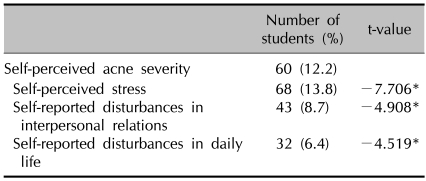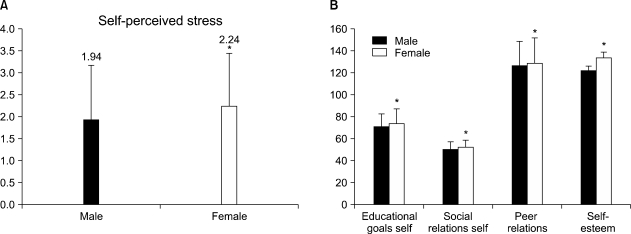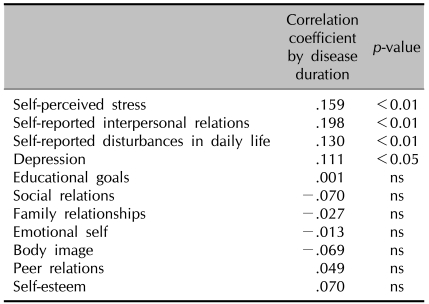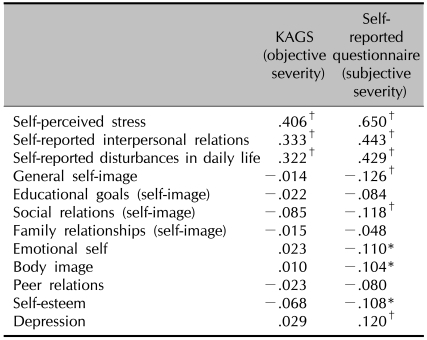Abstract
Background
Acne vulgaris is a distressing condition that affects the majority of adolescents, but the impact of acne vulgaris on the psychological aspects in this age group is poorly understood.
Objective
The purpose of this study was to determine the prevalence of acne, and the level of emotional, social, and functional impairments among Korean adolescents with acne.
Methods
Five hundred four middle school students (13~16 years) participated. The severity of acne was graded by visual examination using the Korean Acne Grading System. Self-reported questionnaires, including subjective acne severity rating, the Self Image Questionnaire, the Rosenberg Self-Esteem Questionnaire, the Index of Peer Relations, and the Beck Depression Inventory were used to assess psychologic status.
Results
There was a prevalence of acne in 78.9% of the study samples, with 10.2% of students having moderate-to-severe acne. Acne was more prevalent and severe in boys than girls. Participants with severe acne and girls had higher levels of emotional and social impairments. The longer the acne persisted, the more stress the students felt. The degree of stress and extent of self-image impairment were related to subjective severity more than objective grading.
Conclusion
Acne is a common disorder among Korean adolescents and appears to have a considerable impact on mental health. Dermatologists should be aware of the importance of basic psychosomatic treatment in conjunction with early medical, educational intervention in the management of acne.
Keywords: Acne vulgaris, Adolescents, Psychological stress, Psychosocial aspects
INTRODUCTION
Acne is a common inflammatory dermatosis which most frequently affects the face during adolescence1. Although acne does not cause direct physical impairment, it can produce a significant psychosocial burden2. It has been suggested that patients with moderate-to-severe acne suffer from poor body image, low self-esteem, and experience social isolation and constriction of activities3,4. As part of the emotional impact, increased levels of anxiety, anger, depression, and frustration are also observed in patients with acne5. Given the fact that acne causes psychologic suffering, acne can affect social, vocational, and academic performance of teenagers.
The majority of studies on the psychosocial impact of acne have been conducted among patient groups in the US and Europe2,5-7. The purpose of the present study was to determine the prevalence of acne with an objective acne grading scale, and to evaluate the levels of emotional, social, and functional impairment among Korean adolescents with acne using age-appropriate and well-validated generic measures of psychiatric status. To prove effective clinical care with adjunctive psychotherapy is thought to be mandatory for maintenance or restoration of psychological well-being, and some of the psychological effects can be reversed by effective clinical intervention with psychological encouragement8. It is thus essential to uncover those at risk of experiencing a psychologic problem and to identify variables predicting this impairment.
MATERIALS AND METHODS
Subjects and methods
Five hundred thirteen students, 13~16 years of age, were recruited in this cross-sectional survey from 1 middle school located in Seodaemun-gu, City of Seoul in May 2007.
All students underwent a clinical examination by two dermatologists. The severity of acne was assessed using the Korean Acne Grading System (KAGS), proposed by the consensus conference in 20049. The severity score (grades 1~6) was as follows: grade 1, <10 papules; grade 2, 11~30 papules; grade 3, >31 papules and <10 nodules; grade 4, 11~20 nodules; grade 5, 21~30 nodules; and grade 6, > 31 nodules (Fig. 1).
Fig. 1.
Objective acne severity scoring by the Korean Acne Grading System (total number of students: 459).
The self-reported questionnaires included a subjective acne severity rating, self-perceived stress, and interpersonal relations and disturbances in daily life (none/mild /moderate /severe /very severe). When students were asked to complete the questionnaires, those replying that each item had been > severe were defined as having a high-score status. High-score frequencies were expressed as the number of affected students per total persons.
Four measures of psychometric evaluation were applied to assess specific psychosocial impairments, which were as follows: (i) Self Image Questionnaire (SIQ), developed by the Korean psychologist, Song (1983) and revised by Han (1992)10; (ii) Rosenberg Self-Esteem Questionnaire (SEQ)11; (iii) Index of Peer Relations (IPR)12; and (iv) Beck Depression Inventory (BDI)13. The SIQ consists of a 116 item questionnaire generating 6 factor scores, which focused on general self, educational goals and achievement, social relations, familial relationships, and emotional self and body image. In the Rosenberg SEQ test, the responses to 10 items were rated on a 4-point scale (strongly disagree to strongly agree), yielding scores between 10 and 40, with higher scores indicating higher self-esteem11. The IPR reflected problems in peer relationships. With 7-rated 25 items, a score >35 indicated a significant problem with peer relations12. The BDI is a reliable and easy-to-use screening instrument and has received worldwide application in both psychiatric and non-psychiatric patient populations. Each item contains 4 statements, scored 0~3, indicating an increasing symptom severity, and total scores ranging from 0~63. The cut-off scores were defined as follows: (i) ≥10, mild symptoms of depression; (ii) ≥19, moderate symptoms of depression; and (iii) ≥30, severe symptoms of depression13. The subjects who scored >30 on the BDI evaluation were considered to have severe depression or suicide thoughts and excluded from this study.
Statistics
Data were analyzed with a t-test to compare the psychosocial index for gender and the presence of acne. To correlate between disease duration, severity, and the psychosocial index, a Pearson product-moment correlation was used with SPSS version 13.0 (SPSS Inc., Chicago, IL, USA). A probability level of <0.05 was considered significant. All p-values were two-sided.
RESULTS
Among 513 students, 504 students, 13~16 years of age, including 253 boys (50.2%) and 251 girls (49.8%), completed the psychosocial index questionnaires and clinical examination. From the objective analysis (KAGS), 78.9% of the students had acne (220 boys (55.3%) and 178 girls (44.7%)), and 10.2% of students had severe acne beyond grade 4 (Fig. 1). Boys were more likely to have severe acne than girls (grade 2.07 vs. 2.04, p<0.05). The mean age of onset was 13.9 years (mean age of boys, 14.2 years; mean age of girls, 13.7 years), and 7.6% reported having a history of medical treatment.
On the self-perceived subjective acne severity rating, 60 students (12.2%; 26 boys and 34 girls) reported having 'problem acne' (high-score status). Table 1 shows that the quality of life impairment in teenage students could be caused by the presence of acne. From the self-reported questionnaire, high-score self-perceived stress was reported by 68 students (13.8%), impairment in interpersonal relationships by 43 students (8.7%), and disturbance in daily life, especially in academic performance, by 32 students (6.4%).
Table 1.
The number of students (frequencies %) with the high-score (>severe) psychosocial impairments induced by acne
*Correlation is significant at the 0.05 level (2-tailed)
Separate analysis of self-reported questionnaires by gender (Fig. 2) showed that scores were worse for girls than for boys with respect to several factors, including self-perceived stress, educational goals, social relations, peer relations, and self-esteem (p<0.05).
Fig. 2.
Comparison of the psychosocial impairment scores by gender, regarding (A) self-perceived stress, (B) educational goals, social relations, peer relations, and self-esteem by gender. *p-value<0.05 (2-tailed).
According to the duration of acne, the younger acne began, the more stress students felt regarding the impairments in interpersonal relations and disturbances in daily life. Depression scores were also significantly increased in long-persisted acne group (p<0.05; Table 2). In comparing the psychometric variables with each objective and subjective acne grade of severity, the degree of stress and extent of self-image impairment were related more directly to the subjective grade of acne severity than to the objective grade of acne grading (KAGS). General self-image, social relationships, and depression were significantly correlated with the subjective grade of severity (scores of self-reported questionnaires), although these variables did not correlate with the KAGS. Additionally, neither objective nor subjective severities showed significant relationships with educational goals, peer relationships, and family relationships (Table 3).
Table 2.
Correlation coefficient between disease duration and psychosocial impairments
ns: not significant
Table 3.
Correlation coefficient between objective/subjective acne severity and psychosocial impairments
*Correlation is significant at the 0.05 level (2-tailed), †Correlation is significant at the 0.01 level (2-tailed)
DISCUSSION
Acne has been found to be associated with mental health symptoms in the previous studies. Kilkenny et al14 conducted a computerized survey of 2,525 Australian adolescents and found self-rated moderate acne to be associated with an increasing frequency of psychiatric symptoms, as measured by the revised Clinical Interview Schedule. Smithard et al6 studied 317 students 14~16 years of age in the UK. They measured the severity of acne with the Leeds acne grading technique and emotional/behavioral symptoms with the Strength and Difficulties questionnaire (SDQ), and found that those with acne were more likely to score in the abnormal/borderline range for emotional or behavioral symptoms, with an odds ratio of 1.86 (95% confidence interval, 1.03~3.34). Consistent with our results, high SDQ scores were significantly associated with female gender (F=27.6, p<0.001) and definite acne (F=3.9, p<0.05).
Comparison of the prevalence rates between studies are generally hampered by varied methods of acne grading, the wide range of diagnostic criteria, and the population characteristics (e.g., age range and ethnicity)6,14,15. The rates of prevalence in the range of 41.7% to 93.3% have been reported in different countries with populations 12~18 years of age. Smithard et al6 reported that 56% of boys and 45% of girls, 14~16 years of age were affected, whereas other studies reported prevalence rates in >90% for males and 80% for females amongst adolescents, and ≥16 years of age using the Leeds Acne Grading Scale16,17. Although our results are not directly comparable for the populations 13~16 years of age, the KAGS used for objective scoring in this study reflected clinical and epidemiological characteristics of Korean acne patients. The KAGS has been found to have a high inter- and intra-rater reliability and lesion counting has been acknowledged to be more reliable than global assessments of acne severity9.
Many new dermatology- or acne-specific questionnaires have recently been developed6,18,19, and they tend to ask people how and to what extent their skin disease affects them. Although SDQ scores assess emotional and behavioral difficulties in five domains (conduct, hyperactivity, emotional symptoms, peer problems, and prosocial behaviors), this instrument fails to demonstrate specific values and depression scores6. Our instruments for measuring psychosocial problems in acne were constructed with four major scales, which included specific values and were considered to be key values of psychosocial aspects. These psychometric evaluations might be used as sensitive and responsive patient-assessed measures in evaluation of psychosocial aspects of other dermatologic diseases.
It has only been in recent years that the psychodermatological literature has begun to address the possibility that acne may have a differential psychological and emotional impact according to gender19-21. The differences between male and female scale scores suggest that the psychological impact of acne may be greater for women than it is for men. Our gender difference research also illustrated that girls are likely to experience greater psychological difficulties than boys across a wide range of psychological factors, including self-perceived stress, educational goals, social relations, peer relations, and self-esteem. It is likely that the gender difference observed in this study is due to the different level of cosmetic concern and perception regarding the appearance in relation to gender, thus it may exert differential psychological strain upon girls.
The strength of this study was in the large number of adolescents surveyed from the general population, thus excluding the possibility of referral bias and overestimation of psychometric morbidity with hospital-based data. Until now, all of the studies about psychologic problems of acne in Korea have been performed in the hospital setting22-26. Acne measurement by self-reported questionnaire with clinical examination provided more available data about acne prevalence, and subjective and objective severity.
The major limitation of this study was its cross-sectional design. Although the acne status and stressful condition are variable and easily affected by other factors, we did not consider them in the evaluation of data. To demonstrate the influence of such confounding factors, including seasonal variation, difference in pubertal stage, medication, hygiene behavior, and menstrual cycle, a prospective study is needed. In order to overcome other limitations, such as narrow age range and the population of a specific district, our research base needs to be expanded and increased in its methodologic complexity.
Our survey confirmed that acne is a common problem for Korean adolescents, affecting 78.9% of middle school students. The results from this community-based study support findings from research with clinical groups that acne is associated with increased psychological morbidity. Participants with definite acne had significantly high-score self-perceived severity, stress, and disturbances in interpersonal relationships, daily life, and academic performance. These impairments were significantly associated with long disease duration, female gender, and severity of subjective perception. In parallel with previous findings25, subjective ratings were more related to self-image, self-esteem, social relations, and depression scores regardless of objective severities. This suggests that the impact of acne can be more serious for the patients than most clinicians think it would be and it is more important to focus on the subjective perception in managing acne patients, irrespective of the objective severity. Using the specifically designed psychometric evaluation, this study suggested the importance of screening for psychosocial problems in those who present for management of acne. It is important for all health service workers to be cautious about psychological morbidity in young people, and especially dermatologists should be aware of the importance of basic psychosomatic treatment in conjunction with medical treatment in the management of acne.
References
- 1.White GM. Recent findings in the epidemiologic evidence, classification, and subtypes of acne vulgaris. J Am Acad Dermatol. 1998;39:S34–S37. doi: 10.1016/s0190-9622(98)70442-6. [DOI] [PubMed] [Google Scholar]
- 2.Koo J. The psychosocial impact of acne: patients' perceptions. J Am Acad Dermatol. 1995;32:S26–S30. doi: 10.1016/0190-9622(95)90417-4. [DOI] [PubMed] [Google Scholar]
- 3.Fried RG, Wechsler A. Psychological problems in the acne patient. Dermatol Ther. 2006;19:237–240. doi: 10.1111/j.1529-8019.2006.00079.x. [DOI] [PubMed] [Google Scholar]
- 4.Koo JY, Smith LL. Psychologic aspects of acne. Pediatr Dermatol. 1991;8:185–188. doi: 10.1111/j.1525-1470.1991.tb00856.x. [DOI] [PubMed] [Google Scholar]
- 5.Thomas DR. Psychosocial effects of acne. J Cutan Med Surg. 2004;8(Suppl 4):3–5. doi: 10.1007/s10227-004-0752-x. [DOI] [PubMed] [Google Scholar]
- 6.Smithard A, Glazebrook C, Williams HC. Acne prevalence, knowledge about acne and psychological morbidity in mid-adolescence: a community-based study. Br J Dermatol. 2001;145:274–279. doi: 10.1046/j.1365-2133.2001.04346.x. [DOI] [PubMed] [Google Scholar]
- 7.Walker N, Lewis-Jones MS. Quality of life and acne in Scottish adolescent schoolchildren: use of the Children's Dermatology Life Quality Index (CDLQI) and the Cardiff Acne Disability Index (CADI) J Eur Acad Dermatol Venereol. 2006;20:45–50. doi: 10.1111/j.1468-3083.2005.01344.x. [DOI] [PubMed] [Google Scholar]
- 8.Rubinow DR, Peck GL, Squillace KM, Gantt GG. Reduced anxiety and depression in cystic acne patients after successful treatment with oral isotretinoin. J Am Acad Dermatol. 1987;17:25–32. doi: 10.1016/s0190-9622(87)70166-2. [DOI] [PubMed] [Google Scholar]
- 9.Sung KJ, Rho YS, Choi EH, Oh JJ, Lee JH, Kim S, et al. Korean acne grading system. Korean J Dermatol. 2004;42:1241–1247. [Google Scholar]
- 10.Song IS. The human mind and self-concept. 1st ed. Seoul: Yangseowon; 1989. [Google Scholar]
- 11.Rosenberg M. Society and the adolescent self image. 1st ed. Princeton, NJ: Prinston University Press; 1965. [Google Scholar]
- 12.Hudson WW. The clinical measurement package: a field manual. 1st ed. Chicago: Dorsey Press; 1982. [Google Scholar]
- 13.Beck AT, Ward CH, Mendelson M, Mock J, Erbaugh J. An inventory for measuring depression. Arch Gen Psychiatry. 1961;4:561–571. doi: 10.1001/archpsyc.1961.01710120031004. [DOI] [PubMed] [Google Scholar]
- 14.Kilkenny M, Stathakis V, Hibbert ME, Patton G, Caust J, Bowes G. Acne in Victorian adolescents: associations with age, gender, puberty and psychiatric symptoms. J Paediatr Child Health. 1997;33:430–433. doi: 10.1111/j.1440-1754.1997.tb01635.x. [DOI] [PubMed] [Google Scholar]
- 15.Freyre EA, Rebaza RM, Sami DA, Lozada CP. The prevalence of facial acne in Peruvian adolescents and its relation to their ethnicity. J Adolesc Health. 1998;22:480–484. doi: 10.1016/s1054-139x(97)00277-2. [DOI] [PubMed] [Google Scholar]
- 16.Rademaker M, Garioch JJ, Simpson NB. Acne in schoolchildren: no longer a concern for dermatologists. BMJ. 1989;298:1217–1219. doi: 10.1136/bmj.298.6682.1217. [DOI] [PMC free article] [PubMed] [Google Scholar]
- 17.Pearl A, Arroll B, Lello J, Birchall NM. The impact of acne: a study of adolescents' attitudes, perception and knowledge. N Z Med J. 1998;111:269–271. [PubMed] [Google Scholar]
- 18.Purvis D, Robinson E, Merry S, Watson P. Acne, anxiety, depression and suicide in teenagers: a cross-sectional survey of New Zealand secondary school students. J Paediatr Child Health. 2006;42:793–796. doi: 10.1111/j.1440-1754.2006.00979.x. [DOI] [PubMed] [Google Scholar]
- 19.Uslu G, Sendur N, Uslu M, Savk E, Karaman G, Eskin M. Acne: prevalence, perceptions and effects on psychological health among adolescents in Aydin, Turkey. J Eur Acad Dermatol Venereol. 2008;22:462–469. doi: 10.1111/j.1468-3083.2007.02497.x. [DOI] [PubMed] [Google Scholar]
- 20.Kellett SC, Gawkrodger DJ. The psychological and emotional impact of acne and the effect of treatment with isotretinoin. Br J Dermatol. 1999;140:273–282. doi: 10.1046/j.1365-2133.1999.02662.x. [DOI] [PubMed] [Google Scholar]
- 21.Krowchuk DP, Stancin T, Keskinen R, Walker R, Bass J, Anglin TM. The psychosocial effects of acne on adolescents. Pediatr Dermatol. 1991;8:332–338. doi: 10.1111/j.1525-1470.1991.tb00945.x. [DOI] [PubMed] [Google Scholar]
- 22.Lee SH, Park TH, Kang WH, Whang KK, Lee CW, Sung KJ, et al. A statistical analysis of acne patients who visited university hospitals recently. Korean J Dermatol. 1996;34:386–393. [Google Scholar]
- 23.Kim HJ, Lim YS, Choi HY, Myung KB. A study on quality of life of patients with acne. Korean J Dermatol. 1998;36:850–854. [Google Scholar]
- 24.Kang MJ, Hahm JH. Comparative study of acne on clinical features and patient understandings in adolescence and post-adolescence. Korean J Dermatol. 2000;38:589–599. [Google Scholar]
- 25.Lee SH, Ahn BK. The quality of life of acne patients. Korean J Dermatol. 2003;41:1271–1277. [Google Scholar]
- 26.Lee SH, Cho HS, Seung NR, Jung SJ, Kim CW, Jo HJ, et al. Quality of life of acne patients. Korean J Dermatol. 2006;44:688–695. [Google Scholar]







